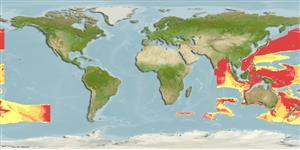Common names from other countries
>
Lophiiformes (Anglerfishes) >
Diceratiidae (Double anglers (Ref. 07463) or Doublespine Seadevils (Ref. 86949))
Etymology: Diceratias: Greek, di = two, double + Greek, keras or keratos = horn, horned (referring to the two conspicuous dorsal-fin spines in the larvae and young females) (Ref. 86949).
More on author: Günther.
Environment: milieu / climate zone / depth range / distribution range
Ökologie
seewasser bathypelagisch; tiefenbereich 533 - 2306 m (Ref. 86949). Deep-water
Indo-Pacific: Bay of Bengal, Papua New Guinea and the Philippines.
Size / Gewicht / Alter
Maturity: Lm ? range ? - ? cm
Max length : 11.2 cm SL Männchen/unbestimmt; (Ref. 39830)
A species of Diceratias with esca having distinct anterior and posterior appendages.
Distinguishing characteristics of metamorphosed female: relatively small esca, width about equal to length; low rounded terminal escal papilla; well developed anterior and posterior escal appendages, usually bearing small secondary filaments; bulbous anterior escal appendage, sometimes branched; laterally compressed posterior escal appendage, row of small secondary filaments along outer margin, at most 5; posterobasal margin of terminal papilla with escal pore; lower jaw with 14-65 teeth, upper jaw with 18-99 teeth; vomerine teeth 4-9 (Ref. 86949).
Specimens captured in closing trawls or taken in open nets (Ref. 86949).
Life cycle and mating behavior
Maturities | Fortpflanzung | Spawnings | Egg(s) | Fecundities | Larven
Kailola, P.J., 1987. The fishes of Papua New Guinea. A revised and annotated checklist. Vol. 1. Myxinidae to Synbranchidae. Research Bulletin No. 41. Department of Fisheries and Marine Resources, Port Moresby, Papua New Guinea. 194 p. (Ref. 6993)
IUCN Rote Liste Status (Ref. 130435)
CITES (Ref. 128078)
Not Evaluated
Bedrohung für Menschen
Harmless
Nutzung durch Menschen
Tools
Zusatzinformationen
Download XML
Internet Quellen
Estimates based on models
Preferred temperature (Ref.
115969): 2.8 - 6.8, mean 4.5 (based on 969 cells).
Phylogenetic diversity index (Ref.
82804): PD
50 = 0.6406 [Uniqueness, from 0.5 = low to 2.0 = high].
Bayesian length-weight: a=0.01995 (0.00906 - 0.04395), b=3.01 (2.83 - 3.19), in cm Total Length, based on all LWR estimates for this body shape (Ref.
93245).
Trophic level (Ref.
69278): 4.2 ±0.73 se; based on food items.
Fishing Vulnerability (Ref.
59153): Low vulnerability (10 of 100).
